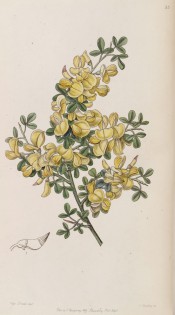Calicotome spinosa (L.) Link.
Frost-tender, thorny, deciduous shrub with alternate, trifoliate leaves and solitary, pea-like, vivid yellow flowers on young shoots in spring and summer. To 2m. [RHSD].
Horticultural & Botanical History
‘Every body who cultivates hardy shrubs knows how difficult it is to settle what is a Genista and what a Cytisus by the old definitions to be found in books, and this difficulty has been increased by the way in which the species have been transferred from one to the other by systematical Botanists. This has arisen from the original adoption of bad marks of distinction, unsuited to the purpose for which they were employed, and the unscientific dread of “innovation” even where most required.
This feeling led to the rejection of Link’s genus Calycotome, although it was perfectly natural, and not to be confused with anything else, and notwithstanding the evident advantage of separating one well-defined group from a mass of species collected together by vague characters. Mr. Bentham, however, has now accepted it, (see Vegetable Kingdom), and no doubt can exist of the propriety of doing so, whether the technical character (deciduous teeth and a truncated membranous edge to a calyx subtended by a bract), or the habit (stiff spiny yellow-flowered bushes) be regarded.
In like manner we look forward with confidence to the reception of Boissier’s genus Retama for Spartiums like S. monospermum, of Grisebach’s Syspone for Genista sagittalis, of the same author’s Lembotropis for Cytisus nigricans, and even to the restoration of the ancient genus Laburnum.
The specimen now figured was raised in the garden of the Horticultural Society, from seeds presented by George Bentham, Esq.
A pretty shrub, capable of withstanding the ordinary winters in the open border, but injured by severe ones. It grows freely in any dry loamy soil, and flowers in June.
It is increased by seed, and is two years before the plants bloom, which is in May.
It occurs in a wild state in various parts of the south of Europe and Barbary, on stony or rocky hills.’ [BR f.55/1846].
Cultivated in England by Gerard as Acatia secunda Mathioli, The Thorne of Egypt, by 1596. [RHSD].
History at Camden Park
Listed only in 1857 catalogue [T.369/1857].
Notes
Cytisus spinosus Desc. (1821-29) = Cytisus antillanus DC.
Cytisus spinosus Sieber ex Steud. (1840) = Cytisus spinescens Sieber
Cytisus spinosus Koch (1843) = Calycotome infesta Guss.
Although it is possible that Macarthur’s plant is one of the alternatives given here Calicotome spinosa (L.) Link. seems the most likely candidate. Listed in Paxton’s Dictionary as Cytisus spinosus, Spartium spinosum is given as a synonym.
Published Dec 17, 2009 - 01:40 PM | Last updated Jul 18, 2010 - 04:51 PM
| Family | Fabaceae |
|---|---|
| Category | |
| Region of origin | Western Mediterranean |
| Synonyms |
|
| Common Name | Spiny broom |
| Name in the Camden Park Record |
Cytisus spinosus |
| Confidence level | medium |


